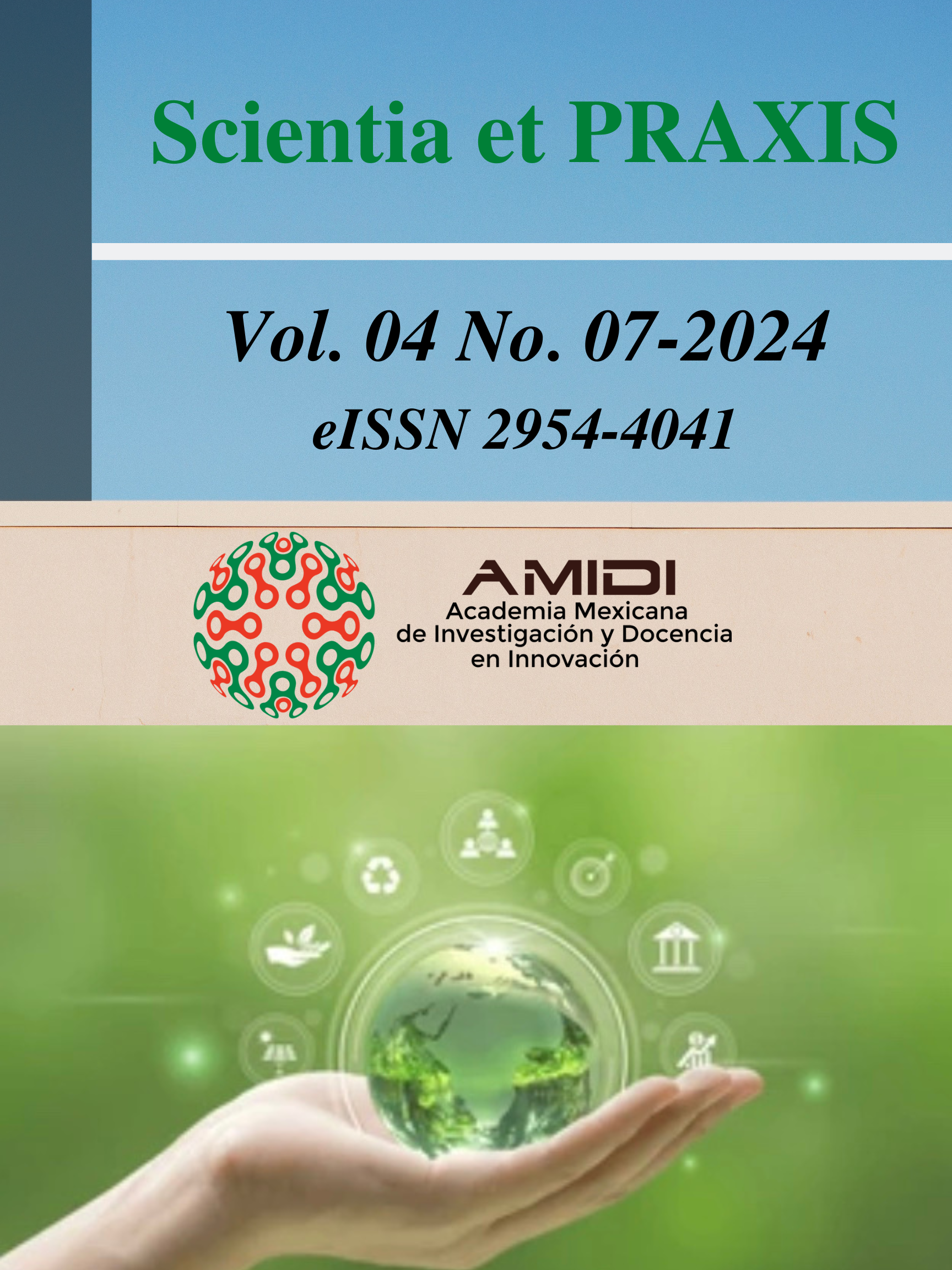Prospective of the socioeconomic sector of beekeeping production in the Yucatán Peninsula, Mexico
DOI:
https://doi.org/10.55965/setp.4.07.a1Keywords:
bees, foresight, micmacAbstract
Context. Beekeeping is an alternative income for families in rural areas of the world, significantly improving their daily lives. The application of good practices for the development of this activity contributes positively to the conservation of the environment, due to the very dynamics of pollination, guaranteeing greater production, if the natural cycle of this process through bees is protected. Local governments must manage laws and policies that promote beekeeping to contribute to social well-being. This study focused on the Yucatan Peninsula as the subject of the study, but the analysis methodologies and results can be replicable for all beekeepers in the country.
Problem. The low income that beekeepers receive in rural areas of the Yucatan Peninsula is the main economic source for their homes. There is an absence of innovative technology and cutting-edge knowledge, poor beekeeping practices, and unfair prices.
Purpose. The objective of this research work was to prospect scenarios to identify socioeconomic problems in the beekeeping sector in the Yucatan Peninsula - Mexico and to make visible the present realities, negative factors, vision and their alternative ecosystems to establish a baseline of possible solutions.
Methodology. Income and population distribution indicators were constructed in the beekeeping sector based on information issued by government entities with open access, to measure poverty. Likewise, a prospecting study was built with the support of producers and key actors based on an analysis of a cross-impact matrix Applied Multiplication for Classification (MICMAC).
Theoretical and Practical Findings. It was identified that the factors that have affected production (flowerings) and negative externalities in the sector are the effects of climate change, the abuse of agrochemicals, the abandonment of units, the lack of involvement of young people, the lack of government support to increase productivity and facilitate mobility and marketing with fairer prices, among others, coinciding with what is stated in specialized and open access literature where different problems involving agricultural issues are addressed. Regarding practical findings, the key variables identified were the type of production, income, health, technology and innovation, and environmental impact. For their part, the determining variables were alliances and cooperation, as well as public policies.
Originality from a transdisciplinary and sustainable innovation point of view. This study was developed with the active participation of beekeepers from the Yucatan Peninsula, it was processed through a prospective methodology to graph the best future scenario by prioritizing their vision, addressing their problems, strengthening their knowledge and experiences, identifying the primary actors. , key processes for the development of strategies that contribute to strengthening this activity, materialized in fairer income to have a dignified life.
Conclusions and limitations. In this regard, it is concluded that the baseline of possible solutions must be focused on the key variables identified, from a multifactorial and multidisciplinary perspective. These studies are limited if we do not work hand in hand with the public sector when promoting public beekeeping policies, credits, and the intervention of academia and science institutes is required, and above all, the involvement of consumers.
Downloads
References
Amaya-Rodríguez, G., Gracia, M. A., Estrada Lugo, E. I. J., y García Barrios, L. (2018). La construcción de lo público-colectivo desde las unidades domésticas en el municipio de Bacalar,Quintana Roo . En Revista de El Colegio de San Luis 8, 51–76. DOI: https://doi.org/10.21696/rcsl8172018788
https://www.scielo.org.mx/scielo.php?script=sci_arttext&pid=S1665-899X2018000300051
Arango-Morales, X. A., y Cuevas-Pérez, V. A. (2014). Método de análisis estructural: matriz de impactos cruzados multiplicación aplicada a una clasificación (MICMAC). Tirant Lo Blanch. Consultado el 30-Nov-2023, de:
https://gc.scalahed.com/recursos/files/r161r/w25569w/Metodo%20de%20analisis%20estructural.pdf
Baena-Díaz, F., Chévez, E., Ruiz de la Merced, F., y Porter-Bolland, L. (2022). Apis mellifera en México: producción de miel, flora melífera y aspectos de polinización. Revisión. Revista Mexicana de ciencias pecuarias, 13(2), 525-548. DOI: https://doi.org/10.22319/rmcp.v13i2.5960
https://www.scielo.org.mx/scielo.php?script=sci_arttext&pid=S2007-11242022000200525
Breeze, T. D., Dean, R., y Potts, S. G. (2017). The costs of beekeeping for pollination services in
the UK–an explorative study. Journal of Apicultural Research, 56(3), 310-317.
Berlien-Araos, K. (2021). Pensar y hacer economía social y solidaria. Revista Economía, 72(116).
https://doi.org/10.29166/economia.v72i116.2628 DOI: https://doi.org/10.29166/economia.v72i116.2628
Consejo Nacional de Evaluación de la Política de Desarrollo Social (CONEVAL, 2020). Medición de la pobreza. Consultado el 30-Nov-2023, de:
https://www.coneval.org.mx/Medicion/MP/Paginas/Pobreza_2020.aspx
Contreras-Escareño, F., Pérez Armendáriz, B., Echazarreta, C. M., Cavazos Arroyo, J., Macías-Macías, J. O., y Tapia-González, J. M. (2013). Características y situación actual de la apicultura en las regiones Sur y Sureste de Jalisco, México. Revista mexicana de ciencias pecuarias, 4(3), 387-398.
https://www.scielo.org.mx/scielo.php?pid=S2007-11242013000300009&script=sci_abstract&tlng=pt
Contreras-Orozco, L. (2017). Calidad gubernamental y colaboración ciudadana en la era tecnológica. Universidad Autónoma del Estado de México, MA Porrúa.
http://ri.uaemex.mx/handle/20.500.11799/95219
Detsch, C. (2018). Transformación social-ecológica del sector agrario en América Latina. In Pasos y actores claves. Buenos Aires: Friedrich Ebert Stiftunng y Nueva Sociedad.
https://library.fes.de/pdf-files/bueros/mexiko/15196.pdf
Di Masso-Tarditti, M., Ezquerra Samper, S., y Rivera-Ferre, M. G. (2021). Mujeres en la Economía Social y Solidaria: ¿alternativas socioeconómicas para todas? CIRIEC-España, Revista de Economía Pública, Social y Cooperativa, 102.
https://doi.org/10.7203/ciriec-e.102.17557 DOI: https://doi.org/10.7203/CIRIEC-E.102.17557
Fondo de Información sobre Biodiversidad Global (GBIF, 2021). Acceso abierto y gratuito a datos de sobrediversidad. Consultado el 30-Nov-2023, de:
Fonteneau, B., Neamtam, N., Wanyama, L., Pereira, M., y de Poorter, M. (2010). Economía social y solidaria: construyendo un entendimiento común. Documento de Trabajo. Consultado el 30-Nov-2023, de:
Garzón-Castrillón, M. A., Orozco Quintero, D., y Ramírez Gañan, A. E. (2020). Gestión de la felicidad, bienestar subjetivo y satisfacción laboral. Dimensión Empresarial, 18(2). https://doi.org/10.15665/dem.v18i2.2057 DOI: https://doi.org/10.15665/dem.v18i2.2057
Gobierno del Estado de Yucatán. (2018). El Gobierno del Estado al rescate de la actividad Meliponicultura. Secretaría de Desarrollo Rural. Consultado el 30-Nov-2023, de:
http://www.desarrollorural.yucatan.gob.mx/noticia/ver/750
Godet, M. (2010). La Prospective “Pour penser et agir autrement ». Métodos de prospectiva. MicMac, versión: 5.3.0. OS: Windows. Idioma: español. Consultado el 01-Sept-2023, de:
Godet, M., & Durance, P. (2007). Prospectiva Estratégica: problemas y métodos. Cuadernos de LIPSOR, 104 (20), 169-187.
https://archivo.cepal.org/pdfs/GuiaProspectiva/Godet2007.pdf
Godet, M., Monti, R., Meunier, F., y Roubelat, F. (2000). La caja de herramientas de la prospectiva
estratégica. Gerpa. Consultado el 30-Nov-2023, de:
https://hal-lara.archives-ouvertes.fr/hal-02185401/document
Güemes-Ricalde, F. J., Echazarreta-González, C., Villanueva, R., Pat–Fernández, J. M., y Gómez–Álvarez, R. (2003). La apicultura en la península de Yucatán. Revista Mexicana del Caribe, 16, 117-132.
Instituto Nacional de Ecología A.C. (INECOL, s. f.). Una voz de alarma por las abejas. *Estudiantes Posgrado INECOL A.C. Consultado el 06-Nov-2023, de:
Instituto Nacional de Geografía y Estadística (INEGI, 2020). Encuesta Nacional de Ingresos y Gastos de los Hogares (ENIGH). Nueva serie. Consultado el 14-Dic-2023, de: https://www.inegi.org.mx/programas/enigh/nc/2020/
Kaboré, B. A., Dahourou, L. D., Ossebi, W., Bakou, N. S., Traoré, A., y Belem, A. M. G. (2022). Socioeconomic and technical characterization of beekeeping in Burkina Faso: case of the Center-West Region. Revue d’élevage et de médecine vétérinaire des pays tropicaux, 75(1), 3-8. DOI: https://doi.org/10.19182/remvt.36861
Magaña-Magaña, M. Á., Moguel Ordóñez, Y. B., Sanginés García, J. R., y Leyva Morales, C. E. (2012). Estructura e importancia de la cadena productiva y comercial de la miel en México. Revista mexicana de ciencias pecuarias, 3 (1), 49-64.
https://www.scielo.org.mx/scielo.php?pid=S2007-11242012000100004&script=sci_abstract&tlng=pt
Malagón-Vélez, L. E. (2021). Aportes conceptuales de la economía social y solidaria a la economía circular. Cuadernos de Administración, 37 (70).
https://doi.org/10.25100/cdea.v37i70.10824 DOI: https://doi.org/10.25100/cdea.v37i70.10824
Mayorga-Cerón, J. H. (2012). Caracterización de la cadena productiva de miel en El Salvador. Caracterización de cadenas productivas en El Salvador. Consultado 30-Nov-2023, de:
http://52.165.25.198/handle/11324/16323
Moreno-Ortiz, A. L. (2023). Importance of Agricultural Activity and Social Innovation in Public Research Centers: a Bibliometric Analysis. Scientia et PRAXIS, 3(05), 1–33. https://doi.org/10.55965/setp.3.05.a1 DOI: https://doi.org/10.55965/setp.3.05.a1
Organización de las Naciones Unidas para la Alimentación y la Agricultura (FAO, 2003). Consultado el 30-Nov-2023, de: https://www.fao.org/3/J0633s/J0633s.htm
Quimis, D. C., Toala, G. M., Buri, V. D. R. S., y Zavala, J. M. (2019). Análisis socio–económico de los productores de miel de abeja en el sitio Quimis, después del desastre natural 16ª. Polo del Conocimiento: Revista científico-profesional, 4(3), 61-77. DOI: https://doi.org/10.23857/pc.v4i3.917
https://dialnet.unirioja.es/servlet/articulo?codigo=7164276
Rodríguez, M. C., Pereira, H., y Vittaz, C. (2022). Sustainable apiculture as a vector for rural development. Comité Científico Internacional, 71. Consultado el 28-Nov-2023, de:
https://revistas.unal.edu.co/index.php/refame/issue/download/5875/1897#page=71
Rubio-Herrera, A., y Castillo-Burguete, M. T. (2014). Mujeres mayas en Yucatán: experiencia participativa en una organización productiva . In Convergencia 21, 39–63. Consultado el 03-Nov-2023, de:
https://www.scielo.org.mx/scielo.php?script=sci_arttext&pid=S1405-14352014000100002
Saha, J. C. (2002). Apicultura para el desarrollo rural–su potencial y apicultura contra la pobreza-desde la perspectiva de Bangladesh. Comisión permanente de Apicultura para el desarrollo rural. Bangladesh. Consultado el 30-Nov-2023, de:
http://www.fiitea.org/foundation/files/018s.pdf
Samaniego, J. (2008). Cambio climático y desarrollo en América Latina y el Caribe: una reseña. Comisión Económica para América Latina. Consultado el 30-Nov-2023, de:
https://repositorio.cepal.org/bitstream/handle/11362/3640/1/S2009028_es.pdf
Secretaría de Agricultura y Desarrollo Rural. SADER. (2023). De alto impacto productivo ambiental, actividad polinizadora de las abejas: Villalobos Arámbula. Consultado el 15-Sep-2023, de:
Tarazona, A. L., y Ríos, A. R. (2021). Efectos de la inseguridad Ciudadana en el bienestar de la DOI: https://doi.org/10.56238/cpahjournalv5n1-012
población. Ciencia Latina Revista Científica Multidisciplinar, 5(3), 3341–3352.
https://ciencialatina.org/index.php/cienciala/article/view/535
Vázquez-Elorza, A. (2021). Regional Wealth with Biodiversity and Socioeconomic Marginality. Scientia et PRAXIS, 1(01), 9–16. DOI: https://doi.org/10.55965/setp.1.01.02
https://doi.org/10.55965/setp.1.01.a2 DOI: https://doi.org/10.55965/setp.1.01.a2
Vidales-Gonzáles, C. (2013). En diálogo: Metodologías horizontales en ciencias sociales y culturales. Comunicación y Sociedad, 20, 239–247. DOI: https://doi.org/10.32870/cys.v0i20.224
Published
How to Cite
Issue
Section
License
Copyright (c) 2024 Ariel Vázquez-Elorza, Neith Aracely Pacheco-López, Alba Lucia Moreno-Ortiz, Jéssica Geraldine Villatoro-Hernández.

This work is licensed under a Creative Commons Attribution-NonCommercial 4.0 International License.











